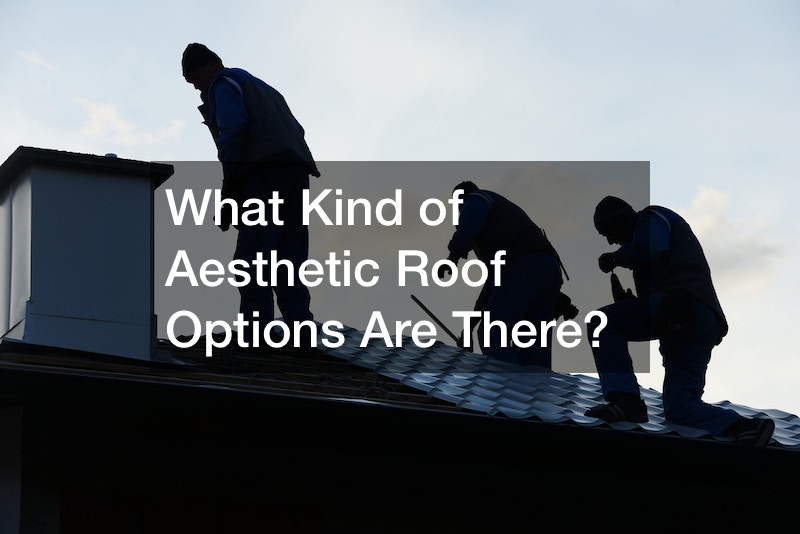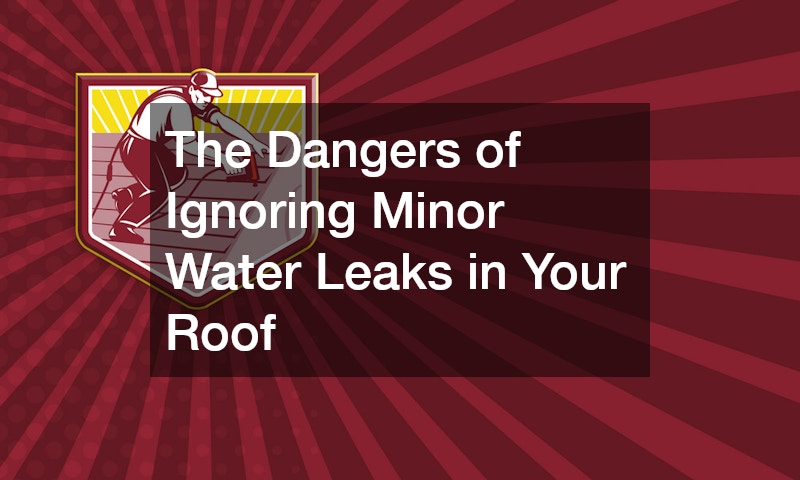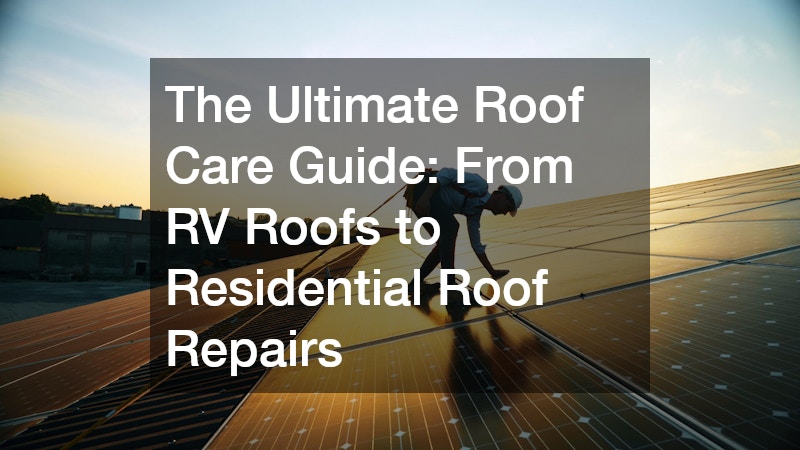Everyone needs a roof over their heads. It is the most important aspect of a house because it provides shelter. Without a roof, the interior would be open to the elements, and things would not work. But besides being the most important part of the house, it also needs to look good and have a good roof aesthetic.
A good quality roof can last a long time with proper maintenance. Depending on what it is made of, it can last anything from 25 to almost 100 years without needing a replacement.

Asphalt
Asphalt shingles are one of the more common coverings used on roofs. The residential roofing companies favor them because they give an aesthetic roof appearance, are durable, and lightweight. Asphalt shingles are one of the most inexpensive roof coverings on the market and are easy to install. With all that going for them, they are also a choice that will give your home that sought-after curb appeal.
You can choose from many different styles and colors that will meet all your needs.
Metal Roof
When people talk about metal roofs, they usually think about steel roofs. But these days, there are many more metals than steel that you can install to give you that perfect aesthetic roof. New construction roofing companies prefer using metal over asphalt because metal provides many benefits: it has a lower impact on the environment, it is safer than the standard asphalt shingle, it is more durable, and it allows consumers more choices in the way the finished roof looks.
Metal roofs are environmentally friendly. The material to manufacture the roof sheeting comes from recycled metal. It can be fitted over the existing roof, which reduces the waste that ends up in a landfill and provides a cost-benefit, with the owner saving money on removing the old roof.
They are also durable. The estimated average lifespan of a metal roof is 30-60 years. Using metal to cover your roof is safer than traditional asphalt roof covering because it makes it resistant to wind, lightning, and fire.
The main metals used in roofing construction include zinc, copper, aluminum, and steel. Aluminum roofs are great for properties close to the coast, as they are rust-resistant, and can easily withstand harsh, salty air and wind. Copper roofs are also rust-resistant but are much more costly to install. Still, many government buildings have copper roofs installed because they are very durable and can last for hundreds of years.
Zinc used to be more commonly used in the past, but currently, it has fallen out of favor because of limited availability and cost of stock for suppliers.
To help you choose the best roof for you, contact the metal roofing contractor.

Slate Roof
Slate is one of the most durable roof materials on the market today. The average lifespan of a slate roof is between 50 to 200 years. If you install a slate roof on your home, it will be the last roof installation you will need for the rest of your time living in that house. The material is on the high end of the price range, but its durability outweighs the initial cost outlay by saving you money in the long run.
The natural aesthetic roof covered in slate tile gives your home that classic look that will make your home look good in any neighborhood. Slate can be cut into different sizes and shapes of tiles and comes in various colors, so you can choose the exact look you want for your home.
One of the great advantages of owning a slate roof is that it is virtually maintenance-free. It resists fire, water, mold, temperature, and weather hazards.
One drawback of installing a slate roof is its weight. You must ensure the trusses can support the roof’s weight once laid. Also, it will cost more to transport, so you should consider buying from a local contractor instead of one far away from your home.
Tile Roof
The tiled roof is distinctively durable and makes a unique roof aesthetic. It is a good choice for quality and durability. Tile roof coverings have been valued for hundreds of years by residential roofers.
Today’s roof tiles come in many shapes and colors and can also be molded to resemble wood shakes, chipped stone, and shingle-style slate. All these possible choices give a discerning homeowner the freedom to decorate their roofs as they please.
Typical roof tile is made from a mixture of clay and concrete, which makes it exceptionally resistant to water, wind, fire, frost, and insect damage. It also makes it environmentally friendly using materials that don’t deplete natural resources or cause toxic environmental damage, like asphalt shingles. Tiles are made of natural materials without preservatives so that they can be recycled back into the manufacturing process without the need for landfills.

Flat Roof
Flat roofs are built with a very low pitch, giving the surface the appearance of being almost level. The main advantage of building a flat roof as opposed to the usually pitched one is that far less material is needed to cover the surface area of the roof.
In the past, flat roofs were mostly built by a commercial roofing company to cover warehouses, factories, and other industrial buildings, mainly due to the cheaper construction costs.
Flat roofs exist all over the world but originated in arid countries where there is less rainfall and freezing temperatures do not occur. They are not suitable for climates with high rainfall and snowfall. The low pitch makes the roof prone to accumulate water (or snow), and the moisture can seep into the roof structure and walls. If the water freezes inside the soaked building materials, it will cause the material to crack. Due to how it is constructed, water leaking often goes unnoticed until it soaks the decking and insulation materials, leading to expensive replacement costs. Most of the time, you will need to replace a roof that has leaked because the accumulated moisture causes the decking material to rot, weakening the roof’s structure and causing a health hazard.
Green Roof
Green roof construction provides a different type of aesthetic roof. It consists of soil usually packed onto a flat roof decking, and grass or other plant material is allowed to grow in the soil.
Vikings first used this type of roof construction, but it is rare in modern architecture. This type of roof can be successful if you ensure no large rooting plants take hold in the soil on top of the roof. The excessively robust root system can damage the integrity of the surface, and you may need to invest in expensive roof repairs.
Some systems have an additional root barrier membrane on top of the waterproofing membrane to provide extra protection against damage by the plant roots.
A well-planted soil layer provides a good insulation and heat buffer for the building. The green roof stores the heat during the day and releases it at night, keeping the inside temperature even.
The most common plant used for green roofs is sedum. It is a type of succulent ground cover plant that requires little maintenance and has a small root system. The main benefit of using sedum as your green roof covering is that it changes color from green to brown to purple depending on the season, which makes it a great aesthetic roof.
Rolled Roofs
Rolled roofing material is made of mineral oil-coated asphalt product, available in 100-meter rolls. It’s very lightweight, only 75 pounds per roll. Unfortunately, it is not as durable as other roof materials. The good news is that it is available in hardware stores, so it’s great for covering roofs of smaller structures like sheds, gazebos, and garages.
It is a great roof covering to use by DIY enthusiasts and provides an aesthetic roof. Similar to asphalt shingles in the way it looks. It can be applied over an existing roof after some careful preparation. Basically, the surface you are applying rolled roofing needs to be immaculately clean and free of debris, as the asphalt roll is easy to puncture and loses its ability to be waterproof. Installation is as simple as cutting the required length of the roll and placing it on the roof surface.
Please note that rolled roof material is not suitable for all types of roofs. Mostly low-pitched can be covered by a rolled roof. If you are unsure if your roof can handle the rolled roof cover, it’s best to contact a roofing services company for advice.

Membrane Roofs
Membrane roofs are also known as single-ply roofing systems. Applying membrane products will give you a durable, watertight, and energy-efficient finish. You can use it for a new roof installation, especially if your roof is flat or low slope.
There are various types of membrane roofing available on the market for you to choose your aesthetic roof.
Polyvinyl chloride (PVC) membrane roofing, also known as vinyl roofing – It is made from synthetic plastic material. Vinyl roofs provide an energy-efficient option that is durable and resistant to UV rays. The other benefits comprise fire resistance and ease of installation because the material is not very heavy. PVC comes in light colours, so if you want a light-coloured roof, then this is a great option for you.
Cold-applied liquid membrane (CALM) – is a paint-on version of membrane roofing material. It is made from a combination of asphalt and elastomeric polymers, giving it abundant flexibility, watertightness, and the ability to cover all protrusions and other roof details. One thing to remember, it needs to be applied in a thick coat. If you are stingy with the material during application, it will crack and become useless in a very short time.
Modified bitumen – It is a material made by combining asphalt with reinforcing materials like fiberglass or polyester. It provides good flexibility and durability. It is also fire-resistant and UV-resistant. It is often used in commercial structures because it is easy to install over large surface roof areas.
Wood Roof
If you are a fan of a natural aesthetic roof, then perhaps investing in a roof made from wood is a great choice for you. It definitely gives a home a rustic and unique look.
Wood roofs can be made into two types of design. A rugged wood shakes roof for that rustic look or a more consistent and polished wood shingle roof. Either way, you will have a roof that has an organic feel as it changes color with age.
Wood roofs take a lot of maintenance. You need to be meticulous about roof washing, staining, and sealing because this porous material is susceptible to pests, mold, and decay. Wooden roofs are also more prone to fire damage. Still, with good maintenance, they can last for many years.
Wood is also a good insulator, so the roof is environmentally friendly and will keep your home warm in winter and cool in summer, saving you money on electricity bills.
The wooden roof is also not the most expensive option, with costs well below what you would need to pay for a slate-covered roof or copper metal roof.
Clay Tile Roof
Clay tile roof is otherwise known as the ‘Old-World’ charm aesthetic roof. This roofing material is durable, versatile, eco-friendly, and provides a low-maintenance option to homeowners. It comes in a variety of shapes and colors to complement your home’s architectural style.
It can be used anywhere in the world as it is appropriate to use in both warm and cold climates. It can withstand rain, snow, and sun. The average lifespan of a clay roof is 50 years.
From a homeowner’s perspective, choosing clay tiles as your roof covering is a great choice. The only complaints may come from your roofer, as clay tiles are heavy, and they need to carry them up to where they need to be placed.
As you see, there are many aesthetic roof options available for you to choose from. Most people base their decision on what material they will use to cover their roof by considering the size and shape of their roof, the local climate, and the budget constraints. We hope reading this post helped you find more about the various roof coverings available on the market and will make your final choice easier.




